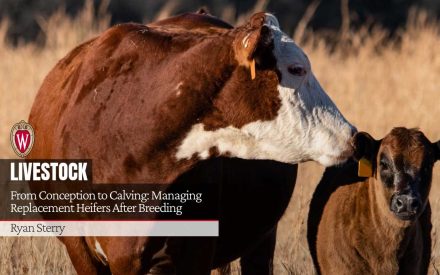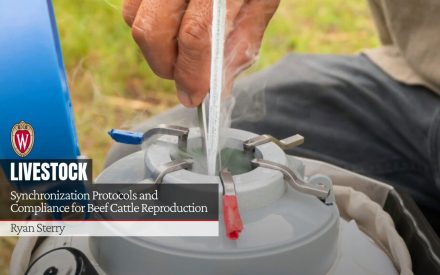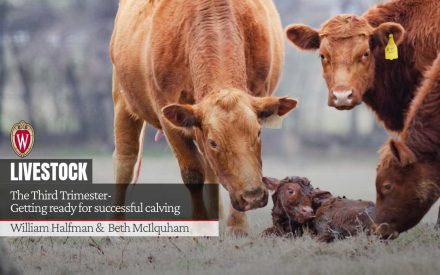Additional downloadable resources for this article are available below in PDF format.
These materials provide guidance on cleaning and sanitizing equipment, giving, storing, and using vaccines properly, as well as placing the vaccine correctly in the animal.
Multi-dose (repeater) syringes are commonly used for vaccinating groups of animals. Transfer needles are used to quickly and cleanly mix vaccines. The risk for inactivating vaccines, and the risk for tissue irritation or abscess formation increases when contaminated syringes and transfer needles are used.
Properly cleaning, sanitizing, and storing multi-dose syringes and transfer needles will reduce contamination from many viruses, bacteria, and fungi. The steps described here use only tap and distilled or deionized (purified) water and do not render the equipment sterile. While not killing all microbes, these steps are acceptable for cleaning and sanitizing this equipment.
Two types of syringes are available
Disposable multi-dose syringes and vacutainer needles (which may be used as a transfer needle) are available. These are sterile out of the package for use during one processing event. Change the syringe if the inside of the barrel or tubing becomes contaminated (for example with dirt, blood, or body fluids). Read the label to determine if these syringes may be re-used after sanitizing with heat. Use a new vacutainer needle each time a product is mixed, as they are single-use items.
Non-disposable multi-dose syringes and transfer needles should be manufactured to withstand heat sanitization but read the label to verify that. Change to a previously cleaned and sanitized syringe or transfer needle during processing if the inside of the needle, barrel, or tubing becomes contaminated.
Small herd owners should decide if the time and labor required for cleaning, sanitizing, and correctly storing multi-dose syringes and transfer needles between events is better served by using disposable products.
Cleaning
You will need a clean work area, stove, or microwave, tap (potable) water, a small scrub brush, distilled or deionized (purified) water, and a thermometer to measure the water temperature. Wash and dry your hands before starting.
1. Begin by brushing the syringe exterior and mechanism in warm tap water. Use a mild soap if the exterior is excessively dirty but keep soap away from the inside of the barrel and the syringe tip where the needle attaches. Repeatedly rinse with clear water.
2. Next using hot (180⁰ F) purified water, repeatedly rinse the syringe interior (barrel and/or tubing) and transfer needles. If possible, disassemble the syringe for better rinsing. Three to five rinses are adequate.
Heat Sanitize
Boil or microwave transfer needles and all syringe parts that contact the vaccine (barrel, needle attachment, plunger, and tubing). It is not necessary to sanitize the syringe mechanism.
- Stove: bring purified water to a boil. Completely submerge the syringe or the disassembled syringe parts, and tubing. Boil for 5 minutes.
- Microwave in wet towels: wrap 5-10 layers of wet paper towels around an individual syringe or its disassembled parts. If not disassembled, fill barrel with purified water. Fill the tubing with purified water. Place the wet paper towel-wrapped syringe and tubing in an open plastic resealable bag. Microwave 5 minutes on HIGH. The paper towels must remain wet otherwise they could start on fire. Multiple wet layers of paper towels will prevent sparks from microwaving metal.
- Microwave in water: Submerge metal transfer needles in a container of purified water and microwave on HIGH for at least 2 minutes. The water must not evaporate to expose the transfer needles. Transfer needles may also be microwaved on HIGH for 2 minutes between layers of wet paper towels as described above for syringes.
Putting it back together
- Re-assemble the syringe while it is still warm without touching the interior surface of the syringe barrel, the syringe tip or plunger.
- The plunger may be lubercated by spraying it with vegatable oil or medical-grade syringe lubercant.
- Lastly, rinse the assembled syringe with hot (> 180⁰ F) purified water. Squirt all remaing water out of the syringe.
Storing
After cooling in a clean, draft-free space, seal the assembled syringe in a plastic bag. Store in a freezer. Bring it to room temperature and rinse with hot (>180⁰ F) purified water just prior to next use. Vaccines do not tolerate heat; let the syringe cool to room temperature (<72⁰F) before filling.
Allow transfer needles to drain and dry before storing them at room temperature in a clean, sealed container.
Autoclaves and pressure cookers
Large herds/feedlots may consider using an autoclave or home pressure cooker (including Instant Pot®) for sterilizing transfer needles and multi-use syringes. Training is needed and the sterilization procedure (pressure, time) is different for every model. You will need to experiment to determine the procedure and verify the equipment’s sterility.
Additional Injection Resources Posters (pdf)
Resources
Rethorst, D. Animal Health Equipment Management. Vet Clin Food Anim 31 (2015) 259-267. http://dx.doi.org/10.1016/J.cvfa.2015.03.009
Griffin, D., et.al. Care of Veterinary Vaccine Syringes. (2002). Historical Mateirlas from University of Nebrasca-Lincoln Extension, 224. https://digitalcommons.unl.eud/extesnionhist/224

 From Conception to Calving: Managing Replacement Heifers After Breeding
From Conception to Calving: Managing Replacement Heifers After Breeding Invest in Superior Bulls Today for Better Profitability Tomorrow
Invest in Superior Bulls Today for Better Profitability Tomorrow Synchronization Protocols and Compliance for Beef Cattle Reproduction
Synchronization Protocols and Compliance for Beef Cattle Reproduction The Third Trimester- Getting ready for successful calving
The Third Trimester- Getting ready for successful calving


